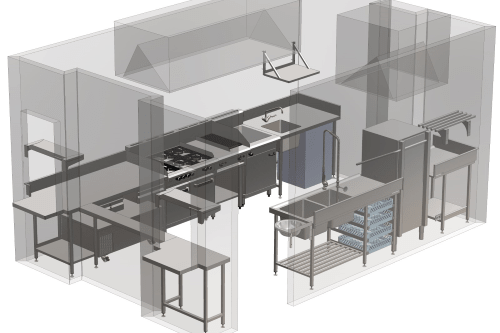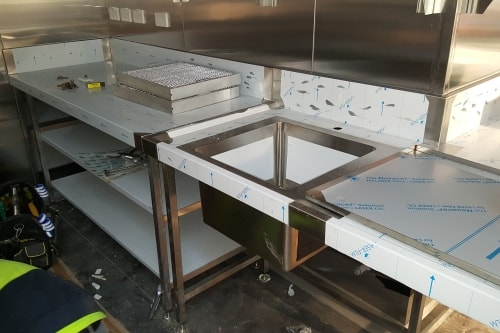Step 1: Vision, Consultation And Planning
Overview:
The first thing to have when designing a commercial kitchen is of course the vision. You need to have an idea about the type of kitchen, the location, the design, the size, and the general mode of operation. This information is then brought to your kitchen hospitality design specialist and gone over in detail. The initial plan will be explored, reinforced, and made into a feasible plan that allows for budget constraints, finance options, and a more specifically attuned equipment list.
Sub-Steps:
- Formulate a clear and thought-out plan.
- Consultation with professionals.
- Budget / finance plan & equipment ideas.
Step 2: Site-Visit, Preliminary Design And Plan Adaptation

Overview:
After the initial step you should have a well-rounded idea that fits both your initial vision and the commercial kitchen consultant’s advice. From here, the next step is a visit to the site to get measurements and an experience of the area. This new information is then brought back to the original plan where adjustments are made.
Sub-Steps:
- Site measured and information recorded.
- Layout sketched and updated with new information.
- Plan adapted and updated to suit new details.
Step 3: CAD Drawing And Technical Design

Overview:
Now that the vision is fully thought-out, the site has been measured, and the details are collected the technical designing can begin. Our in-house design team create a 3D representation of the kitchen-to-be that offers a glimpse of the finished product from any angle. This allows for extremely precise attunement of the design and the equipment that may include custom fabrication options.
Sub-Steps:
- Kitchen representation created as 3D model.
- Design specification documents created.
- Customised items designed and added.
Step 4: Custom Design And Fabrication

Overview:
Commercial kitchens come in a variety of shapes and sizes, as you would know by this stage. As such, the large stainless steel kitchen equipment and surfaces will likely need to be customised in order to optimise the space and flow of the kitchen. Our design team create (and modify) custom stainless steel items including benches, canopies, and wall sheeting, refrigerators and other large items. This is carried out by our in-house fabrication team.
Sub-Steps:
- Custom items designed and added to plan.
- Customised equipment drawn-up and added.
- Items are fabricated and prepared for delivery.
Step 5: Delivery And Installation

Overview:
Once the custom items have been made, and the equipment that needed customisation has been modified, the next stage is to get everything delivered and installed. This process includes getting the dates and times set, having all the right people ready to work, and getting everything moved, fitted, attached, plugged in, plumbed up, and finally taking off the scratch-resistant plastic.
Sub-Steps:
- Installation plan made.
- Items packed up and delivered.
- Kitchen equipment and items installed.
Step 6: Completion And Service

Overview:
Once everything is installed and the kitchen is ready to use the next step is to deliver all the small kitchen items that you need (pots, pans, spatulas, and so on). After that, the kitchen is completely fitted out. You will have a collection of user-manuals, documentation and other important paperwork that should be stored away securely. If you need service or support, call us.
Sub-Steps:
- Kitchen stocked with small items.
- Paperwork is securely and safely stored.
- Our phone number is ready in case of service or support.

